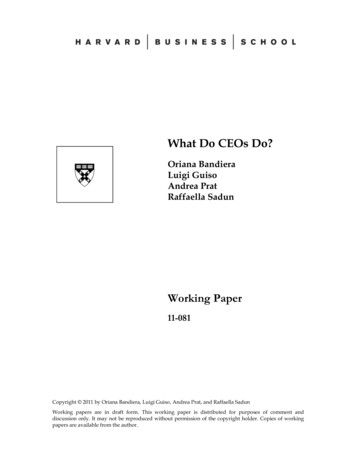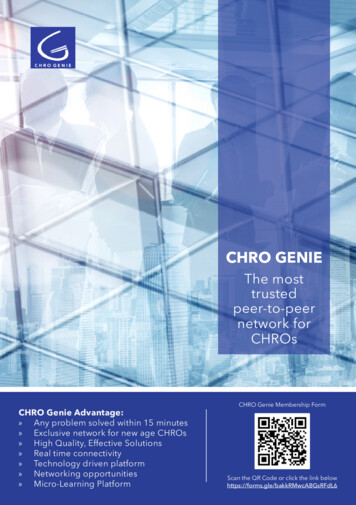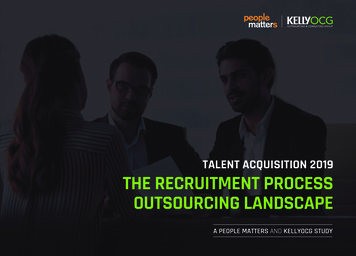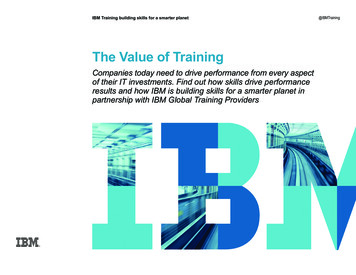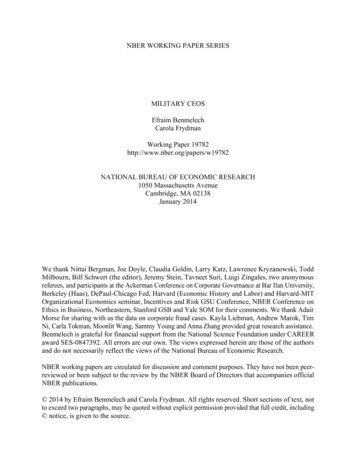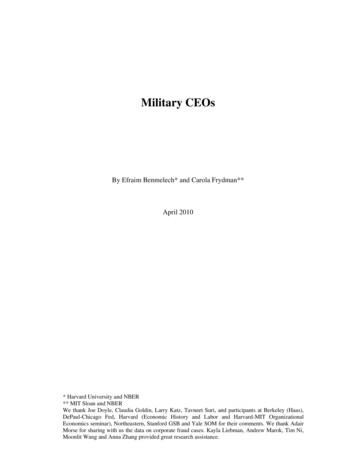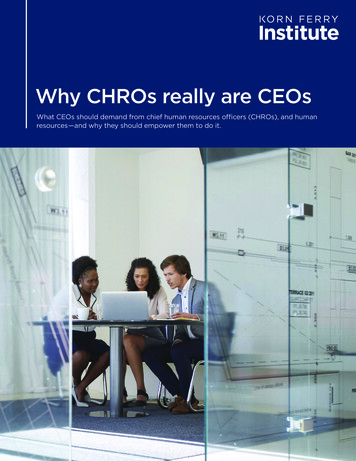
Transcription
Why CHROs really are CEOsWhat CEOs should demand from chief human resources officers (CHROs), and humanresources—and why they should empower them to do it.
1Leaders of the talent agenda.I recall the term “staff officer” from my service in the US Army. It was a termmost officers dreaded. Staff time in the Pentagon or in a battalion meant thatyou were doing “administrative” work—not out leading troops. Historically, asimportant as chief financial officers (CFOs) or chief marketing officers (CMOs)were to businesses, they were still seen as “staff functions”—more administrativethan strategic, more to serve the business than to drive it. The chief humanresources officer (CHRO) role was no different in this regard.But staff functions now must be strategic, and leaders in these roles must workaccordingly. CFOs were the first to feel this pressure. More than a decade ago,CEOs wanted CFOs to be strategic partners, helping to drive the business. ButCFOs were developed by a generation of finance professionals whose key skillswere getting the books closed, managing the balance sheet, and reporting onwhere the company had been last quarter or last year. They were not forwardlooking as to where the company needed to go. That has changed radically,and CFOs now are seen as leaders and experts in a complex, crucial area fortheir organizations, the C-suite, boardroom, and even in succession as CEOs(Burnison 2015).Today’s CHROs also need to evolve. They should own the human capital agenda.They should operate just as a business unit president who is accountable to theCEO for the success of a business unit. CHROs are in the people business. Theyare the CEO’s lead service provider for the enterprise’s talent agenda—not theadministrative agenda alone, but also the strategic and tactical talent agenda.That includes all aspects at all levels, including the C-suite. “An effective C-Suiteleader must operate like a CEO—thinking broadly about the levers to pull tocreate value,” says John Berisford, former McGraw-Hill Financial CHRO and nowPresident of Standard & Poor’s. “For a CHRO, it’s all about alignment of talent tothe growth and performance agenda.”Today’s CHROsneed to evolve.They should ownthe human capitalagenda. Theyshould operate justas a business unitpresident does, andbe accountable tothe CEO. CHROsare in the peoplebusiness.
WHY CHROS REALLY ARE CEOS2CHROs’ job no. 1:strategic advisors.Business strategies typically fail because of poor execution, often the result ofpoor alignment at the executive committee level and weak collaboration amongthese key leaders. Historically, CEOs led the team and worked to ensure alignmentand collaboration. They once had the time and the energy for this. But that isnow drained by business travel demands, short time horizons required to deliverresults, and overall complexity. (Some CEOs travel more than 100 days a year—asdo many executive committee members).Building a high-functioning leadership team is a people business. It will makeor break successful execution of the business strategy. As the CEO’s top talentadvisor, and given the challenges and complexity, the CHRO should share theresponsibility with the CEO for ensuring a high-functioning executive team.The company’s business strategy and talent agenda depend on this. As goesthe senior team, so goes the business. Beyond the effectiveness of the executiveteam, CHROs must drive the rest of the company’s talent solutions operation.They must decide and execute on talent acquisition, leadership development,human resources technology platforms, compensation, performancemanagement, culture, diversity and inclusion, learning and development,succession planning, employee relations, and a host of other requirements.When taking these requirements beyond the administrative to the level ofstrategic contribution, the CHRO, indeed, is the CEO of a talent solutions business.What a CEO should expect.Unfortunately, some CEOs do not see the human resources (HR) function this way,and some CHROs are not up to this role. In either case, it is unlikely their fault—fewhave seen HR operate this way. It not only should be this way but also is essentialthat it becomes so. Those who launch now will gain the advantage.As one expert described it: “Often HR pros are perceived as only able to dealwith the softer side of business because they are diplomatic, typically positivein outlook and gracious. Others are mocked as the ‘people police’ who demandproper paper processes. The CEO, by contrast, requires an advisor who tells himor her what the key people issues are, and who rigorously influences him or herabout solutions. Sometimes this uncommon role means unfamiliar accountabilityand risk. The CEO, however, needs HR to add value to every function in thecompany, rather than merely define itself by reducing head count.” (Enns 2008).The CHROshould share theresponsibilitywith the CEOfor ensuring ahigh-functioningexecutive team.The company’sbusiness strategyand talent agendadepend on this.
3Many CHROs can step up. Not only should they be performing like CEOs oftalent solutions companies, Korn Ferry data shows that they are among the mostqualified in the C-suite when measured against CEO competencies. (Ulrich andFiller 2014). In a study of executive assessment data, researchers analyzed 360 assessments of thousands of leaders in six C-suite functions—CEO, CFO, COO,CIO, CHRO, and CMO—in which each executive was ranked on 14 aspects ofleadership on a scale from one to seven. The result, as published in the HarvardBusiness Review: The traits of CHROs matched up closely with those of CEOs(see Figure 1). If CHROs are empowered within the organization then they arelikely to be successful in driving strategic human resources solutions.Figure 1How CHROs, CEOs align in key ways.LEADERSHIP STYLESTHINKING STYLESSource: Harvard Business Review. 2014. Why Chief Human Resources Offices Make Great CEOsEMOTIONAL reAmbiguity icipativeIntellectualSocialTask-FocusedCEO, CFO, COO, CIO, CHRO, CMO
WHY CHROS REALLY ARE CEOSEmpowered CHROs.Next-generation CHROs will perform like the CEO of an HR solutions company, enablinghuman capital solutions for their company. They are not administering programs.They are creating impact and a return on the money invested in the company’s talentsystems. With this orientation, CHROs should have a point of view for both the presentand the future. Just as CHROs should be brutally proactive in calling out and mitigatingdysfunction within the executive team, they should do so about all talent systems with aneye on business strategy execution.Those who subscribe to this premise say that what is needed then is a good HR businessplan (talent strategy) and forward-leaning operating style for HR to function as asolutions provider rather than a program administrator. Without this orientation, the HRleader in many cases will fail.A very senior HR leader, for example, was promoted to lead the talent function at a largeglobal company. I congratulated him on what I called his “career change.” He said, “Ihaven’t changed careers, I’ve just been promoted.” I disagreed. He needed to see thisas a career change to break the mold of being an administrative service provider whobasically looked after HR programs. He needed to understand that he had just becomethe CEO of an HR solutions company. In the end, he failed. Feedback from executivesafter his departure had one common theme—he did not engage business units and staffor embrace them as clients strategically. He knew they were his clients. He wanted tohelp them, but he did not effectively engage. One key leader echoed the sentiment ofthe others by saying of this executive, “He sat in his office and waited for us to come seehim.” Few successful solutions company CEOs sit in their offices waiting for clients. Thecompany’s existing talent systems continued to function administratively—it was businessas usual. However, new HR work streams with impact were not created. The shame ofthis is that the executive had a real point of view, was brilliant, and did not seem to lackconfidence. But by failing to lean in and consult from a position of authority, he did notput himself in a position of influence. Therefore, he had little impact, and his clients foundsolutions elsewhere. In outreach, engagement, and relationship building—all essential tobeing a strategic solutions provider—he failed, and so did his staff.4
5In contrast, here’s how the role of a next-generation CHRO might look—and how ittracks perfectly with that of a successful CEO (see Figure 2).Figure 2Comparing next-generation CHROs with CEOs.CEOCHROEstablish a clear mission statement forthe company that sets a strategic toneand clear metrics.Set a strong HR mission statementthat is strategic and measurable.Ensure that the board and executiveteam are aligned on the mission andthe business plan.Ensure that the CEO is alignedwith HR’s mission statement and plan.The CHRO must make this occur withstrong stewardship and advocacy ofthe HR function, supported by a strongmetrics-driven HR business plan.Ensure the company’s mission/directionwill powerfully address client needs.Ensure that the HR plan addresses thebusiness needs, and the executive teamand line and staff leaders agree that HRowns the talent agenda and must bemore than their HR administrator.Install strong leaders as their direct reports.Place strong HR leaders in key roles.Monitor results and modify strategy andtactics.Monitor results and modify the HRstrategy and tactics.This vision of a CHRO’s role requires outreach, engagement, and relationship building.CHROs are leaders first, technical experts second; this explains the need to make themental shift in seeing promotion as a career change. Those who stay in the comfortablebox of technician will not build the key strategic relationships needed to be highly effective.They will not be seen as business-minded commercial thinkers. After building a careerlargely on technical acumen, this can be a difficult shift to make (Dai and Swisher 2015).
WHY CHROS REALLY ARE CEOSA new day for HR?But some companies are moving in this direction, including a Fortune 100 companywhere the CHRO serves effectively as chief operating officer (COO) without the title.As a solutions provider, he is a key advisor to the CEO on talent as a critical businessdriver. He behaves like the CEO of an HR solutions company. He sets strategic goals todrive the business. The company, for example, had a heavy concentration of long-termemployees among its top 250. Innovation had stalled. The culture had ossified intodefending the status quo. The HR leader set a goal: Within a given number of years, thecompany would significantly increase the percentage of the top 250 with fewer than fiveyears’ tenure with the company. This number needed to at least double so the companycould drive innovation. He set this direction and put the actions in motion to deliver.During this time, the CEO role for one of the company’s flagship businesses was filled byan executive from a completely different industry. Four years later, the unit is flourishingin the face of disruptive competition. That’s because the unit abandoned its “that’s theway we have always done it” culture. The company has added dozens of outsiders to thetop 250. When the company faced serious challenges from digital competitors, it couldbetter address the threat.The CHRO has led other big changes, including an HR transformation, an outsourcing ofthe talent acquisition function, a change in HR organizational design, and a revision of theperformance management system. These and other CEO-like leadership behaviors havecreated an HR function—an internal HR solutions company—that this company’s leaderssee as mission critical.Results when HR steps up.Companies historically grew in slow environments. Shareholders sought steady, consistentearnings growth. This once was not nearly as difficult as it is today. Now globalization,complexity of business models, and disruptive technology have changed all that. Nimble,decisive, well-executed HR plans are needed and can have major business impact. WhenHR develops talent processes that create enterprise leaders, the function, one expertanalysis says, can “boost employee performance by 22%, employee retention by 24%,revenue growth by 7%, and profit growth by 9%. In fact, firms with enterprise contributorsoutperform their peers by 5% and 11% on year-over-year revenue and profit growth,respectively. This means that the average Fortune 500 organization can increase profit by 144 million and revenue by 924 million. HR should not make the mistake of thinking thatmost employees aren’t ready or willing to be enterprise contributors. They are, but they’restymied by structure and culture of their firms” (Corporate Executive Board 2015).6
7HR must be courageous.HR’s solutions-oriented muscles must be activated decisively. HR must have apoint of view and be proactive. If CHROs are concerned about a business leader’sperformance, they should step in and recommend actions. Although CHROs canpredict a ranking colleague’s failure, they all too often sit and wait for the CEO tostep in. Instead, the CEO should expect the CHRO to be in the fray, collaboratingand addressing the issue proactively. This is what solutions providers do as trustedadvisors. Failing to adopt this HR leadership approach can be deadly. As HRthought leader John Sullivan has noted, “Weak people-management practiceshave been attributed as the primary causes of failure in a number of notable cases.At Enron and Bear Stearns for example, reward systems that incented dangerousbehaviors easily overpowered the effect of control systems designed to preventfraud and ethical breaches” (Sullivan 2010).While the final numbers have not been tallied yet on recent problems atVolkswagen, a similar meltdown at Toyota several years ago provides insights.As Sullivan has observed, quoting published reports: Toyota lost 155 million andnearly 30 billion in stock valuation. As he writes: “The long-term impacts of theroot causes that led to Toyota’s current situation could cost the company hundredsof billions of dollars. The mechanical failures were known to Toyota leaders longbefore corrective action was taken, and many close to the issue are indicating thatthe company took decisive action to hide the facts and distort the scope of theproblem. The problem was again a rewards issue similar to that at Enron. Whenthe organization disproportionately rewarded managers for cost-containmentversus sustaining product quality, it created the incentive for everyone involvedto ignore the facts and to deny that a problem existed. Employees who are welltrained and subject to balanced rewards and performance monitoring systemswould not have allowed the situation to grow as it did” (Sullivan 2010).Weak peoplemanagementpractices have beenattributed as theprimary causes offailure in a numberof notable cases.
WHY CHROS REALLY ARE CEOSGreat CEOs and CHROsanticipate problems.Let’s consider a likely business situation. A company makes a significant acquisition,and, as often happens, the CEO of the acquired company remains in a key businessleader role. This CEO has independently run the business for years. Now inside amuch larger company, this executive is in an entirely new ecosystem. She is no longerthe ultimate leader with total authority. There are now peers in other units. There isless board access than she had before and a host of other things that are new anddifferent. Often she is confident in navigating this new environment, so she doesn’tseek counsel.In this case, the CHRO can safely anticipate that the acquired CEO is likely to be:nWeak in socializing ideas and collaborating across a matrix.nWeak in managing up and laterally.nBiased toward legacy employees, making the parent company staff feel excluded.nWeak in understanding of the larger company’s culture and norms.nnBiased toward defending current operating processes—the not-invented-heresyndrome.Weak in understanding the need to invest in building strong peer relationships.The CHRO should step in, anticipating these issues, and providing counsel, insistingon putting systems and coaching in place to manage this transition. It’s unlikely theCHRO will be invited in. But as a solutions provider, the CHRO must step in—andobserve and measure the progress.8
9ConclusionHR systems can move the dial as much as any business strategy executed by a business unit (McCabeand Bongiornio 2016). CEOs who miss the mission criticality of HR do so at their peril. HR drives thepeople-related systems of the company just as the chief information officer (CIO) drives technology;this is equally mission critical. CEOs must empower HR. The CHRO must have a point of view, becourageous, and capable of speaking truth to power. CHROs are leaders, not technicians. Kevin Silva,CHRO of Voya Financial, summarized this superbly, saying: “The CHRO needs first to be a businessperson with the same goals and understanding of the business as the CEO and CFO. Only then canthe CHRO bring forward the human capital portion of the strategy, which would then align with theCEO’s and CFO’s vision. When the CHRO stands separate and apart from these two key partners, heor she stands alone and unaligned. When the CHRO stands shoulder to shoulder, the full potentialof the senior team and the business can more readily be realized.” Next-generation CHROs are theCEOs of a critical unit in the company. They should act accordingly. The CEO should require it.ReferencesBurnison, G. 2015. CFO to CEO: The Right-Brain Leadership Gap. Los Angeles: Korn Ferry.Corporate Executive Board. 2015. Key Imperatives for HR in 2015: Insights from CEB’sLeadership Council Research. Washington, DC: CEB.Dai, G., and Vicki Swisher. 2015. Expert Value. Los Angeles: Korn Ferry.Enns, J. 2008. What CEOs Say They Want from HR Leaders. hr.com blogs.McCabe, J., and George Bongiornio. 2016. Measuring Up: HR’s New Need for Leadersin Data Analytics. Los Angeles: Korn Ferry Institute.Sullivan, J. 2010. “A Think Piece: How HR Caused Toyota to Crash.” EREMedia.Ulrich, D., and Ellie Filler. 2014. CEOs and CHROs. Los Angeles: Korn Ferry Institute.AuthorAlan GuarinoVice Chairman, Board and CEO Services 1 845 206 8199alan.guarino@kornferry.com
About Korn FerryKorn Ferry is the preeminent global people and organizational advisoryfirm. We help leaders, organizations and societies succeed by releasingthe full power and potential of people. Our nearly 7,000 colleaguesdeliver services through Korn Ferry and our Hay Group and Futurestepdivisions. Visit kornferry.com for more information.About The Korn Ferry InstituteThe Korn Ferry Institute, our research and analytics arm, was establishedto share intelligence and expert points of view on talent and leadership.Through studies, books, and a quarterly magazine, Briefings, we aim toincrease understanding of how strategic talent decisions contribute tocompetitive advantage, growth, and success. Korn Ferry 2016. All rights reserved.CHROCEOL2016
The chief human resources officer (CHRO) role was no different in this regard. But staff functions now must be strategic, and leaders in these roles must work accordingly. CFOs were the first to feel this pressure. More than a decade ago, CEOs wanted CFOs to be strategic partners, helping to drive the business. But

